Are Montana launch sites real? That’s a question that has been on my mind lately, and I bet you’re curious too. The answer is not only a resounding yes but also a fascinating tale waiting to be unraveled.
I’ve delved deep into the world of missile sites, air force bases, and nuclear missiles. Trust me when I say that Montana is home to some truly extraordinary launch facilities.
Now, I understand that the thought of nuclear missile silos might invoke a mix of curiosity and concern and I’m here to shed some light on the subject.
Montana’s 341st Missile Wing, which includes Malmstrom Air Force Base and F.E. Warren Air Force Base, is an active missile wing with much more than meets the eye.
Together, we’ll uncover the hidden world of missile sites, construction projects, and missile test launches that have taken place in Montana.
- Related article: Complete Montana History
It’s time to discover the stories that lay beneath the surface of those seemingly ordinary county roads and gravel roads. Get ready to be captivated by the wonders of these launch facilities.
Montana Launch Sites Overview

Launch sites, also known as missile silos or underground missile facilities, are vertical cylindrical structures built below the surface. They serve as storage and launching locations for a variety of missiles.
These missiles have different ranges and purposes, and their deployment and use can vary depending on the strategic goals and defense policies of the countries that possess them.
Let’s break down these missiles one by one.
- Intercontinental Ballistic Missiles (ICBMs) – These are long-range ballistic missiles designed to carry nuclear warheads, capable of traveling thousands of kilometers for strategic deterrence.
- Intermediate-Range Ballistic Missiles (IRBMs) – IRBMs are ballistic missiles with a range of 1,000 to 5,500 kilometers (620 to 3,420 miles), capable of carrying both conventional and nuclear payloads.
- Medium-Range Ballistic Missiles (MRBMs) – MRBMs have a shorter range than IRBMs, between 300 to 1,000 kilometers (186 to 620 miles). They can also carry conventional or nuclear warheads.
- Anti-Ballistic Missiles (ABMs) – These are missiles designed to intercept and destroy incoming ballistic missiles in flight, used for missile defense purposes to protect against potential attacks.
In Montana’s history during the Cold War, the state played a vital role in the United States’ defense strategy by hosting a portion of the Minuteman defense missile system.
The state saw the establishment of numerous underground missile silos, with significant concentrations in counties such as Monarch.
The strategic placement of these silos across states like Montana was driven by key considerations, such as proximity to potential threats and secretiveness, often hiding in plain sight.
A significant Montana site, Malmstrom Air Force Base, housed Minuteman ICBMs. These missile bases, including Malmstrom AFB, played a vital role in strategic deterrence.
By showcasing the presence of these missiles, the United States aimed to discourage the Soviet Union from launching a nuclear attack, knowing the devastating response that would follow.
To ensure the constant readiness of these launch facilities, Montana had a network of missile alert facilities (MAFs) connected to the missile silos.
These facilities were staffed around the clock with crews prepared for any imminent launch. The security measures implemented further underscored Montana’s role in maintaining a credible nuclear deterrent.
Over time, the Minuteman ICBMs deployed in Montana’s launch sites were gradually replaced with more advanced Minuteman III missiles.
This strategic endeavor aimed to modernize the nation’s nuclear deterrence capabilities, ensuring it remained at the forefront of missile technology.
With their concealed locations, steadfast security measures, and ongoing modernization efforts, these sites continue to make their mark on the defense landscape, ensuring safety and deterrence.
Montana Missile Silo Locations

These underground structures were designed to shelter and launch intercontinental ballistic missiles (ICBMs) and other ballistic missiles.
Missile silos are typically cylindrical and are used for the storage and launching of missiles. In the context of Montana, these silos housed Minuteman ICBMs during the Cold War.
Montana housed a significant number of nuclear missile silos and launch facilities during the Cold War.
Some of the known locations of Montana’s missile silos and launch facilities include:
- Malmstrom Air Force Base – Located in Cascade County, Montana, Malmstrom AFB is one of the prominent sites associated with the Minuteman ICBM program.
- Great Falls – This city was home to launch facilities and missile silos as part of the missile defense system at Malmstrom Air Force Base.3
- Central Montana – Many of the missile silos and launch facilities were spread across central Montana, taking advantage of its remote and sparsely populated areas.
Montana Launch Sites Appearance

Missile silos are strategically positioned throughout the state and are the epitome of blending into the surrounding landscape. A nuclear missile silo is camouflaged often hidden in plain sight.
A nuclear missile silo, as described by Ian Frazier in his poignant words from “Great Plains,” is a seemingly unremarkable patch of land. Just a couple of acres with a concrete slab and a fence.
To the naked eye, it appears insignificant, blending seamlessly with the rural backdrop. But to the imagination, it holds unimaginable power, capable of bringing about the end of the world.
3 primary reasons guided the placement of these sites:
- Distance – Shortening the missile path between the United States and the Soviet Union by directing them over Canada and the North Pole.
- Protection – Extending the missile path from submarine-launched ballistic missiles (SLBMs) on both coasts, offering more time for detection in case of a nuclear conflict.
- Far Away From Population Centers – Keeping potential targets as distant as possible from heavily populated areas.
Montana is a land dotted with these hidden guardians, concealed in plain sight. Scattered throughout secluded areas, they seamlessly merge with the beauty of their surroundings.
You might find yourself passing one unknowingly, as they cunningly blend into the fabric of the Montana landscape. It’s as if they are whispering a secret, tucked away in the folds of the earth.
Montana Launch Sites Facilities

Montana’s launch site facilities serve as the backbone of the state’s missile defense system.
These crucial infrastructure elements play a vital role in ensuring the efficient and secure operation of the missile silos located across the state.
From Launch Control Centers (LCCs) to support buildings and maintenance facilities, Montana’s launch site facilities are essential for the day-to-day functioning and maintenance of the missile sites.
The 341st Missile Wing, based at Malmstrom Air Force Base, holds the responsibility of overseeing these intercontinental ballistic missile (ICBM) launch sites.
Under the command of the 20th Air Force, the wing provides the critical defense capabilities necessary for national security.
Connected to Malmstrom AFB, these facilities are distributed across various Missile Alert Facilities (MAFs) and Launch Facilities (LFs).
Here are the locations of Missile Alert Facilities:
10th Missile Squadron:
- MAF A-01: 9.3 miles SE of Belt, MT
- MAF B-01: 11.3 miles NW of Stanford, MT
- MAF C-01: 15.2 miles WxNW of Hobson, MT
- MAF D-01: 7.3 miles ExNE of Denton, MT
- MAF E-01: 14.1 miles N of Hilger, MT
12th Missile Squadron:
- MAF F-01: 8.6 miles NxNE of Augusta, MT
- MAF G-01: 13.8 miles SW of Simms, MT
- MAF H-01: 5.9 miles NxNE of Fairfield, MT
- MAF I-01: 11.0 miles ExNE of Cascade, MT
- MAF J-01: 7.0 miles ExNE of Power, MT
490th Missile Squadron:
- MAF K-01: 1.7 miles ExNE of Harlowton, MT
- MAF L-01: 1.3 miles NxNE of Judith Gap, MT
- MAF M-01: 4.1 miles NE of Moore, MT
- MAF N-01: 11.0 miles WxNW of Grassrange, MT
- MAF O-01: 1.5 miles E of Roy, MT
564th Missile Squadron:
- MAF P-00: 2.9 miles NE of Conrad, MT
- MAF Q-00: 9.0 miles E of Ledger, MT
Each MAF consists of underground Launch Control Centers (LCCs) and other support buildings, ensuring the seamless monitoring and control of missile launches.
The Launch Facilities (LFs) themselves are strategically dispersed within the coverage area of each MAF. These facilities represent the advancement of technology, enabling a robust defense system.
- Read more about Defense Stations in Montana
Montana Launch Sites Final Thoughts

Connected to the esteemed 341st Missile Wing at Malmstrom Air Force Base, these facilities are not easily detectable to the untrained eye.
Resting beneath the surface, these launch sites are spread across the stunning expanse of the state, carefully placed to ensure maximum coverage and security.
The significance of Montana launch sites cannot be understated. As part of the United States’ nuclear arsenal, they provide a critical layer of defense, safeguarding the nation’s security.
It is a testament to our technological advancement that such a formidable defense system has been constructed amidst the raw natural beauty of Montana.
Hidden from plain sight, tucked away beneath county roads and gravel lanes, these sites embody a sense of mystery, making one consider the weight of their purpose.
The 341st Missile Wing holds the responsibility of overseeing these sites, and their exceptional efforts ensure that our nation remains safeguarded against any potential threats.
Reflecting on the enormity and importance of these launch sites reminds us of the need for their security and protection.
Their hidden locations and connection to Malmstrom Air Force Base serve as a constant reminder of the lengths we go to safeguard our nation’s defense.
Montana’s launch sites stand as a symbol of our commitment to national security, quietly guarding us against any looming dangers.
Montana Launch Sites FAQs
1. Why Are There Numerous Nuclear Missiles in Montana?
In the 1950s and ’60s Cold War era, responding to the Soviet Union’s 1957 launch of Sputnik, the U.S. strategically bolstered its military capabilities by developing a nuclear triad, featuring land-based ICBMs.
Montana’s spacious and remote landscapes were ideal for deploying these missiles, leading to their placement in missile wings across the state as part of the nation’s defense strategy
2. Why Were Minuteman Sites Constructed on the Great Plains?
Minuteman sites were constructed on the Great Plains for 3 primary reasons:
- To shorten the missile path between the United States and the Soviet Union, given that the Minuteman missiles had a shorter range of 4,300 miles.
- To provide protection against submarine-launched ballistic missiles (SLBMs) from both coasts.
- To keep potential targets far away from densely populated areas.
3. Where Are the U.S. Missile Launch Sites Located?
Located across three key Air Force bases in the Great Plains region, the U.S. missile launch sites are strategically spread out to ensure a robust defense system.
The 90th Missile Wing at F.E. Warren AFB in Wyoming, the 341st Missile Wing at Malmstrom AFB in Montana, and the 91st Missile Wing at Minot AFB in North Dakota house 400 Minuteman III missiles.
If you’re interested in diving deeper into Montana, stay involved with these articles:
- History of Montana’s Cuisine
- Past Milestones in Montana
- Historic Town of Montana
- Unsolved Cases in Montana
- https://www.defense.gov/Multimedia/Experience/Americas-Nuclear-Triad/
- https://www.afnwc.af.mil/Weapon-Systems/Minuteman-III-LGM-30G/
- https://www.nps.gov/articles/minuteman-missiles-on-the-great-plains.htm
- https://coldwarheartland.ku.edu/landscapes/rural-missile-sites
- https://commons.wikimedia.org/wiki/File:490th_Missile_Squadron
- https://nara.getarchive.net/media/an-extreme-long-shot-of-a-minuteman-missile
- https://commons.wikimedia.org/wiki/File:10th_Missile_Squadron

